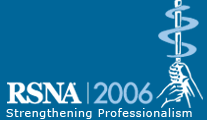
Abstract Archives of the RSNA, 2006
Shlomit Goldberg BA, Abstract Co-Author: Nothing to Disclose
Dominik Fleischmann MD, Abstract Co-Author: Speakers Bureau, Bracco Group
Speakers Bureau, General Electric Company
Speakers Bureau, Siemens AG
Lewis Wexler MD, Abstract Co-Author: Nothing to Disclose
Stanton B. Perry MD, Abstract Co-Author: Nothing to Disclose
Jeffrey A Feinstein MD, Abstract Co-Author: Nothing to Disclose
Frandics Pak Chan MD, PhD, Presenter: Nothing to Disclose
Mark K. Friedberg MD, Abstract Co-Author: Nothing to Disclose
et al, Abstract Co-Author: Nothing to Disclose
et al, Abstract Co-Author: Nothing to Disclose
Characterization of congenital or acquired anomalies of the coronary arteries in young children is important for medical treatment and surgical intervention. Invasive coronary angiography is the principal imaging modality for this assessment. We tested the hypothesis that cardiac-gated CT coronary angiography (CTCA) can provide the same diagnostic information noninvasively.
Following IRB approval, CTCA examinations performed in children less than 5 years old between 2003 and 2006 were retrospectively identified. CT protocol was retrospectively ECG-gated, 0.75-1 mm thin section spiral scan of the heart using bolus tracking technique. The data collected included the origins, courses, and destinations of the major coronary arteries. A standard of reference was established by combining clinical data, echocardiography, catheterization reports, CT imaging, and surgical findings. Two radiologists blinded to the coronary diagnosis reviewed the CT data, and concordance with the standard of reference was determined. Statistical significance was analyzed using binomial statistics.
Twenty-five studies were performed in children ages 1 month-5 years (mean 1.5 years) for suspected anomalous coronaries (n=12) and anomalous coronaries in association with complex congenital heart disease (n=13). The average heart rate was 116 bpm (range 85-147 bpm). For determining the origin of the coronary arteries, concordance with the standard of reference for the two readers was 88% and 92%; for determining the course and destination, concordance was 96% and 84%. All concordance rates were statistically significant (P<0.001).
Despite small coronary arteries and high heart rates in young children, CTCA can accurately characterize anomalies of the coronary arteries, and may serve as a noninvasive alternative.
Cardiac-gated CT coronary angiography is a reliable, noninvasive method of characterizing complex coronary anomalies in young children
Goldberg, S,
Fleischmann, D,
Wexler, L,
Perry, S,
Feinstein, J,
Chan, F,
Friedberg, M,
et al, ,
et al, ,
Cardiac CT Angiography for the Characterization of Coronary Anomalies in Infants and Young Children. Radiological Society of North America 2006 Scientific Assembly and Annual Meeting, November 26 - December 1, 2006 ,Chicago IL.
http://archive.rsna.org/2006/4439502.html

